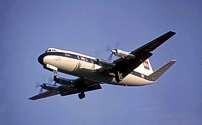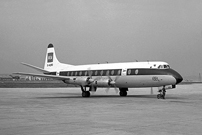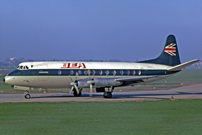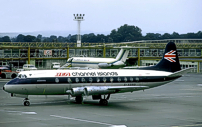
September 1957 to July 1973
British European Airways Corporation (BEA)
G-AORD * - c/n 171 - a V.802 series Viscount
United Kingdom registered
February 1953
An order was placed for the first 800 series Viscount which was specifically designed for British European Airways Corporation (BEA).
This was the 22nd Type 802 ordered by British European Airways Corporation (BEA).
Production Aircraft No. 25 - the 25th production 800 series Viscount built,
was the 23rd 800 type Viscount fuselage assembled at Hurn, Bournemouth, Hampshire, England,
and the 25th 800 series Viscount assembled at Weybridge, Surrey, England.
Production Order No. F22/802. Sales Order No. F22/63B. Stock Order No. F22/26B.
2 January 1956
Registered to British European Airways Corporation (BEA). Registration G-AOHW had been allocated but not taken up.
12 January 1957
Fuselage assembly commenced at Hurn Airport, Bournemouth, Hampshire, England.
March 1957
Fuselage transported by road from Hurn Airport, Bournemouth, Hampshire, England to Weybridge, Surrey, England.
22 March 1957
Fuselage to Erecting Shop 'E' at Weybridge, Surrey, England.
18 July 1957
First flight from Brooklands Airfield, Weybridge, Surrey, England.
It landed at Wisley Airfield, Surrey, England for fitting out and test flying.
7 September 1957
Delivered to British European Airways (BEA) named as 'R M A Arthur Phillip'.
4 August 1958
Noted at Blackbushe Airport, Hampshire, England carrying out crew training circuits.
1959
Noted with the Union Flag on the starboard side of the tail painted on upside down!
It had arrived from Stansted Airport, Essex, England and later returned to London Airport (Heathrow).

BEA
'Red Square' livery
March 1959
A new BEA 'Red Square' livery was adopted and aircraft were repainted during the early 1960s when they next went in for overhaul.
Sadly, after repainting, the aircraft no longer carried a name including the nameplate on the forward cabin bulkhead.
9 March 1959
Noted at Gatwick Airport, Surrey, England carrying out ILS approaches and overshoots.
12 March 1959
Noted at Gatwick Airport, Surrey, England carrying out ILS approaches and overshoots.
31 March 1959
BEA annual report quotes a total time of 3,083 hours.
1 December 1959
Noted at Gatwick Airport, Surrey, England due to a London Airport (Heathrow) weather diversion.
15 December 1959
Noted at Blackbushe Airport, Hampshire, England due to a London Airport (Heathrow) weather diversion.
8 December 1960
Noted at Gatwick Airport, Surrey, England due to a London Airport (Heathrow) weather diversion.
18 December 1960
Noted at Gatwick Airport, Surrey, England due to a London Airport (Heathrow) weather diversion.
23 December 1963
Noted at Gatwick Airport, Surrey, England due to a London Airport (Heathrow) weather diversion.
10 November 1964
Noted at Gatwick Airport, Surrey, England due to a London Airport (Heathrow) weather diversion.
24 January 1966
Noted at Gatwick Airport, Surrey, England due to a London Airport (Heathrow) weather diversion.

Operated the joint
London to Malta route
circa June 1966
Noted operating the London to Malta route with the 'Malta' logos replacing the BEA logos on the cheatline.
This was a 'joint service' with Malta Airlines during the summer season.

BEA
‘Flying Union Jack‘ livery
circa 1968
A new BEA ‘Flying Union Jack‘ livery was adopted and most aircraft were repainted when they went in for major overhaul, which took some of them into the early 70s before this was accomplished.

BEA
'Channel Islands' livery
1971
The Chairman of BEA, Henry Marking, split the airline into several divisions as part of his ‘profit centre’ philosophy, with each division being responsible for it’s own financial performance. As a result the Viscount V.802 fleet was split into two.
The ‘Scottish Airways' division had eight Viscounts based at Abbotsinch Airport, Glasgow, Scotland. The ‘Channel Islands' division had twelve Viscounts with four being operated from Jersey, five from Elmdon Airport, Birmingham, England and one from Guernsey Airport, Channel Islands. The remaining two aircraft were used on a charter to GB Airways to operate the Gibraltar to Tangier, Morocco service, and to act as operational spares.
All aircraft had either ‘Scottish Airways’ or ‘Channel Islands’ titling applied to the upper fuselage. In practice to maintain operational flexibility there was considerable mixing of the aircraft. On one occasion in August 1971 two of the ‘Channel Islands’ Viscounts were on the ramp together at Sumburgh Airport, Shetland Islands, Scotland some 750 miles (1,250 km) from the Channel Islands.
circa August 1971
G-AORD was allocated to the ‘Channel Islands’ division and had ‘Channel Islands' titles applied alongside ‘BEA’ titling on the upper fuselage.
31 July 1973
Transferred to British Airways (BA) due to a corporate merger.
 FURTHER READING: Books about BEA - British European Airways FURTHER READING: Books about BEA - British European Airways
|



